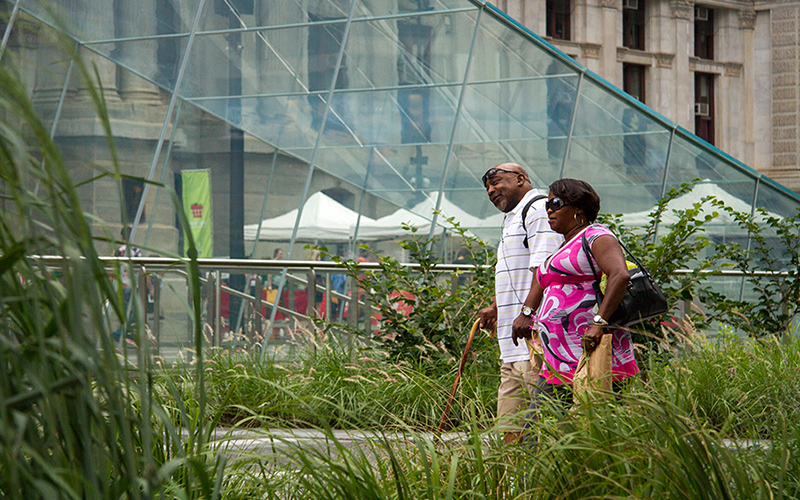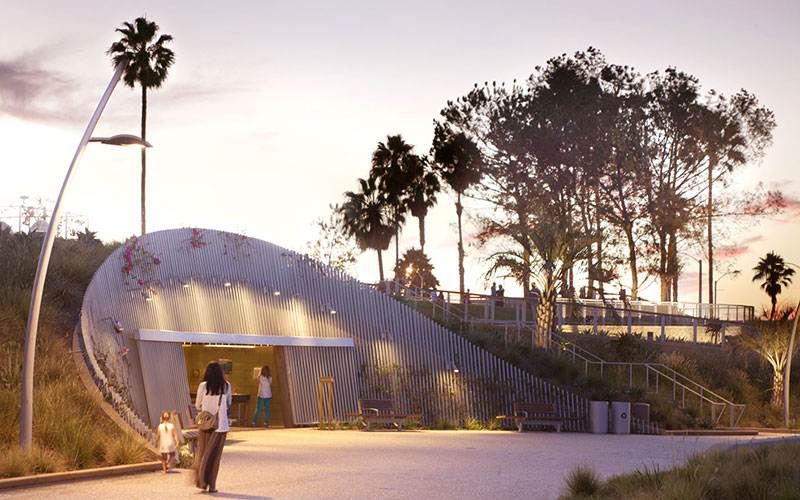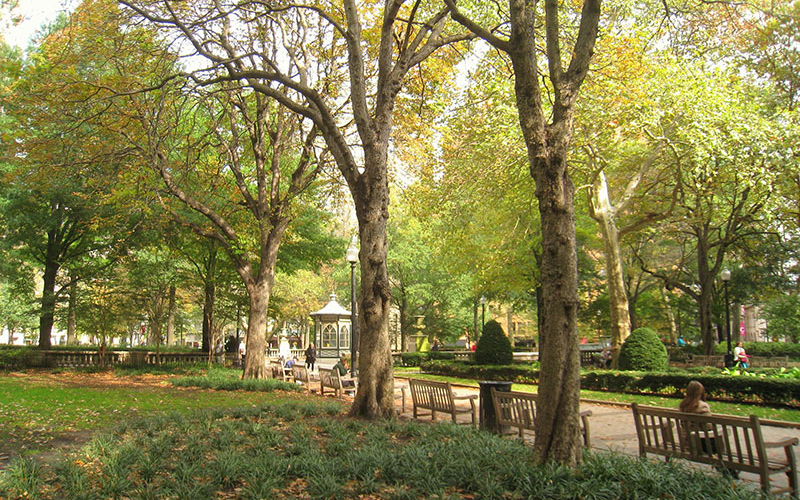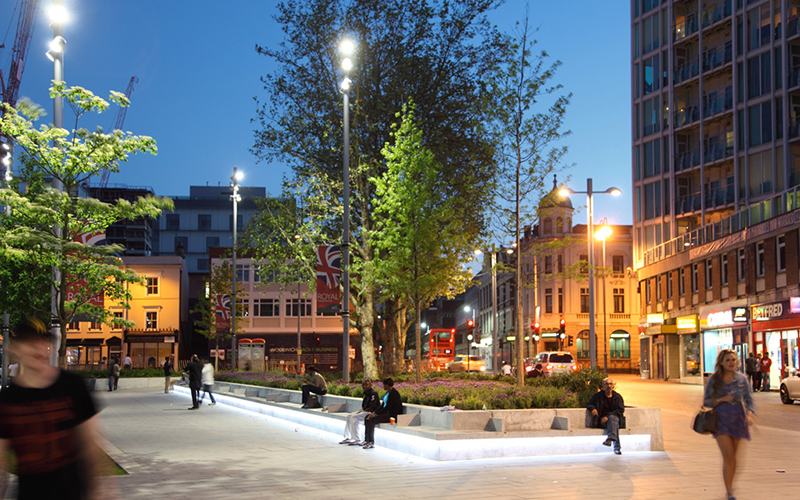Professional Practice
Universal Design: Parks and Plazas
 Dilworth Park is a universally-accessible public plaza at Philadelphia's City Hall. A formerly-sunken plaza was redesigned to be even with street level, eliminating the need for stairs and walls and improving access to City Hall. A water feature at grade creates a place for people to play, while allowing easy navigation around it. Connections to the metro further the connectivity of the park to the rest of the city, creating a civic space that functions for everyone. Dilworth Park, Philadelphia, Pennsylvania, OLIN / Sahar Coston-Hardy
Dilworth Park is a universally-accessible public plaza at Philadelphia's City Hall. A formerly-sunken plaza was redesigned to be even with street level, eliminating the need for stairs and walls and improving access to City Hall. A water feature at grade creates a place for people to play, while allowing easy navigation around it. Connections to the metro further the connectivity of the park to the rest of the city, creating a civic space that functions for everyone. Dilworth Park, Philadelphia, Pennsylvania, OLIN / Sahar Coston-Hardy Parks and plazas are a crucial part of social life, and who can access them conveys who is seen as part of the community. Unfortunately, poorly-designed spaces limit who can use them. Take parks for example, a 2016 study found that while seniors represent 20 percent of the population, they only account for 4 percent of park visitors. Many aspects of parks are not designed with older adults or people with disabilities in mind.
Creating great public spaces is a major design challenge, but universally-designed parks and plazas benefit even more communities. Designing with people with disabilities and older adults, landscape architects and designers can create spaces that are inclusive and welcoming for all.
Universally designed parks and plazas invite everyone to participate in public life by considering these factors:
Connections to the street: Parks and plazas should meet the street at grade, ensuring that anyone can enter the space. When a grade change must be addressed, integrated ramps and stairs create a unified experience regardless of ability. Safe materials that are, tactile, not slippery when wet, and provide high contrast should be chosen.
Clear identity: While maintaining a seamless entry from the street is important, creating a space separate from the street gives identity to the space. Trees can buffer noise and other sensory information from other areas.
Providing options: Public places serve many different groups of people, with differing needs. One solution is not going to accommodate everyone, but the scale of many public places creates room for spaces that give visitors different choices and opportunities.
Ease of access to restrooms: Bathrooms that are easy to locate allow families with children, people with disabilities, and older adults to readily use facilities that everyone needs. Placing bathrooms near streets and along major pathways of parks makes locating restrooms easier if the need arises. Restrooms should be clearly indicated on multi-sensory signage throughout parks and plazas.
In Tongva Park in Santa Monica, James Corner Field Operations put accessible bathrooms at the entrance of the park, directly off the street, enabling all park visitors regardless of ability, age, or housing status to access the facilities.
 The public bathroom is treated as a sculptural element in Tongva Park, meaning it can be seen easily from almost anywhere in the park. It is located along the central spine of the park, easily accessible from the street. ASLA 2018 Professional General Design Honor Award. Tongva Park and Ken Genser Square, Santa Monica, California. James Corner Field Operations LLC / Tim Street-Porter
The public bathroom is treated as a sculptural element in Tongva Park, meaning it can be seen easily from almost anywhere in the park. It is located along the central spine of the park, easily accessible from the street. ASLA 2018 Professional General Design Honor Award. Tongva Park and Ken Genser Square, Santa Monica, California. James Corner Field Operations LLC / Tim Street-PorterIsolated and open: Providing a mix of spaces, enclosed and open, gives people agency in the kind of environment they want to experience. For older adults, open space is important. But autistic, or otherwise neurodivergent people prefer more enclosed and secure environments with less sensory information. Deaf or hard or hearing people also prefer more enclosed and secure environments.
Previewing spaces: Clear lines of perception between spaces allow older adults and people with disabilities to preview spaces and discern if they will feel comfortable. This is important for intellectually and/or developmentally disabled people, as they can anticipate the amount of sensory information a space currently has. Confrontation with unexpected sensory information often causes extreme emotional and psychological distress for people who have difficulty regulating and processing sensory information. Providing the ability to anticipate the sensory environment not only benefits intellectually / developmentally disabled people, but other disabled communities as well.
Comfortable and accessible seating: Many people use mobility devices, and their needs should be accommodated in seating areas. Public furniture should take wheelchair users into account, offering tables and seating that allows them to engage socially in parks and plazas without feeling isolated. According to Americans with Disabilities Act (ADA) standards, tables and furniture should provide space to place or store mobility devices, such as walkers or canes, safely while people relax and while not in use. Arm rests and seat backs on seating are necessary for many older adults to sit comfortably and use public furniture. A variety of seating should be located throughout parks and plazas at regular intervals that can be anticipated. Comfort is also related to temperature so consider sun and shade as well as materials and their conductive properties.
Rittenhouse Square, in Philadelphia, Pennsylvania, features benches with arms along all of its pathways, providing accessible places to sit throughout the square and space for wheelchair users to stop next to the benches. The pathways are wide enough for multiple groups to pass one another. Different materials indicate where to walk and where to rest. The scale of the park creates open areas for gathering and smaller intimate areas where two people can communicate (see below).
 Rittenhouse Square has benches with backs and armrests along all of its wide pathways, offering accessible seating throughout the park. The large trees filter the light, offering sunny and shaded seating. Rittenhouse Square, Philadelphia, Pennslyvania, Thomas Holme and Paul Philippe Cret / Wikipedia
Rittenhouse Square has benches with backs and armrests along all of its wide pathways, offering accessible seating throughout the park. The large trees filter the light, offering sunny and shaded seating. Rittenhouse Square, Philadelphia, Pennslyvania, Thomas Holme and Paul Philippe Cret / Wikipedia Variety of seating locations: Seating should be offered in sunny and shady conditions, allowing people to sit where they feel comfortable. People want to sit in secluded areas as well as open public areas, and comfortable seating should be provided throughout. Trees are an excellent source of shade for parks and plazas.
Moveable seating: Rearranging seating allows groups to re-position themselves in ways that best suit their needs. Chairs should be durable, easily moveable but stable, and not made of aluminum or comparable reflective material. Glare from such furniture can be troubling for people with low vision and older adults. Deaf and hard of hearing people prefer U-shaped benches or circular seating arrangements so they can face one another when they communicate, aiding in their use of sign language and lip reading.
Trees: Trees provide shade, reduce glare, and can create enclosed areas within larger public open spaces. While trees have benefits, they need to be maintained to prevent obstructions into walkways. Leaves, twigs, or fruit falling from deciduous trees can create tripping or slipping hazards or discomfort for those with low vision, cognitive disorders, and older adults. Minimize, and avoid when possible, the use of high allergen trees.
 Consistent lighting at the ground plane and from above make the plaza accessible at night. The seating has arm rests and a back and has trees that offer seating in the shade. The pathway are wide enough that people can have a conversation and not impede people walking throughout the square. Woolwich Square, London, UK, Gustafson, Porter, + Bowman / Gustafson, Porter, + Bowman
Consistent lighting at the ground plane and from above make the plaza accessible at night. The seating has arm rests and a back and has trees that offer seating in the shade. The pathway are wide enough that people can have a conversation and not impede people walking throughout the square. Woolwich Square, London, UK, Gustafson, Porter, + Bowman / Gustafson, Porter, + BowmanWell lit: Lighting is crucial to extending how long people feel safe occupying and moving through public places, and is especially a concern for deaf people or those with low vision, older populations, and women. A consistently well-lit space makes discerning contrasting materials easier, a major concern for the blind and those with low vision when moving through spaces. Lighting is crucial for the deaf and hard of hearing community to use sign language.
Consistent multi-sensory wayfinding: Tactile paving, and the sound of water can indicate to sensory disabled people areas where extra caution is important. Evenly-spaced, predictable arrangements of trees and plants create rhythm through continuous, recognizable visual references, which is particularly helpful for deaf or hard or hearing people.
Safe water: Bodies of water can pose threats to those with limited abilities. Railing that incorporates seating is ideal, providing safe access to the water. If the water feature is shallow and at ground level, using tactile paving to indicate the potential hazard increases safety for blind people and those with low vision.
Organizations
Human Centered Design
National Center on Accessibility
Project for Public Spaces
Resources
Civic Design Guidelines (Free Download), Center for Active Design, 2018
Creating Parks and Public Space for People of All Ages Guide, AARP
Effect of Public Squares on Social Interaction, UK Essays, February 2018
Guidelines for Designing for Persons with Low Vision, National Institute of Building Sciences, June 2011
How Public Space Can Build Community and Rescue Democracy, Common Edge, March 2018
Placemaking for an Aging Population, UCLA Complete Street Initiative, Luskin School of Public Affairs, and Lewis Center for Regional Policy Studies, June 2014
Universal Design in Parks, Mid-America Regional Council, 2016
What Do Seniors need in Parks, The Dirt, May 2015
Research
DeafScape: Applying DeafSpace To Landscape, GroundUp, Issue 07, Alexa Vaughn
Seating in Aged Care: Physical Fit, Independence, and Comfort, SAGE Open Medicine, January 2018, Alethea Blackler, Claire Brophy, Maria O’Reilly, and Marianella Chamorro-Koc
The First National Study of Neighborhood Parks: Implications of Physical Activity, RAND Corporation, May 2016
Projects
Cincinnati John G. and Phyllis W. Smale Riverfront Park, Cincinnati, OH, Sasaki, 2010
Dilworth Park, Philadelphia, PA, OLIN, 2014
Ed Benedict Park, Portland, OR, Koch Landscape Architecture
Rittenhouse Square, Philadelphia, Pa, Paul Phillepe Cret, 1913
Sovereign Square, Leeds, UK, re-form Landscape Architecture, 2016
Tongva Park and Ken Gensler Square, Santa Monica, CA, James Corner Field Operations, 2013, ASLA 2018 Professional Honor Award, General Design
Washington Square Park, New York City, NY, 1871
Woolwich Squares, London, UK, 2012